The Astrophysical Environments of Habitable Worlds
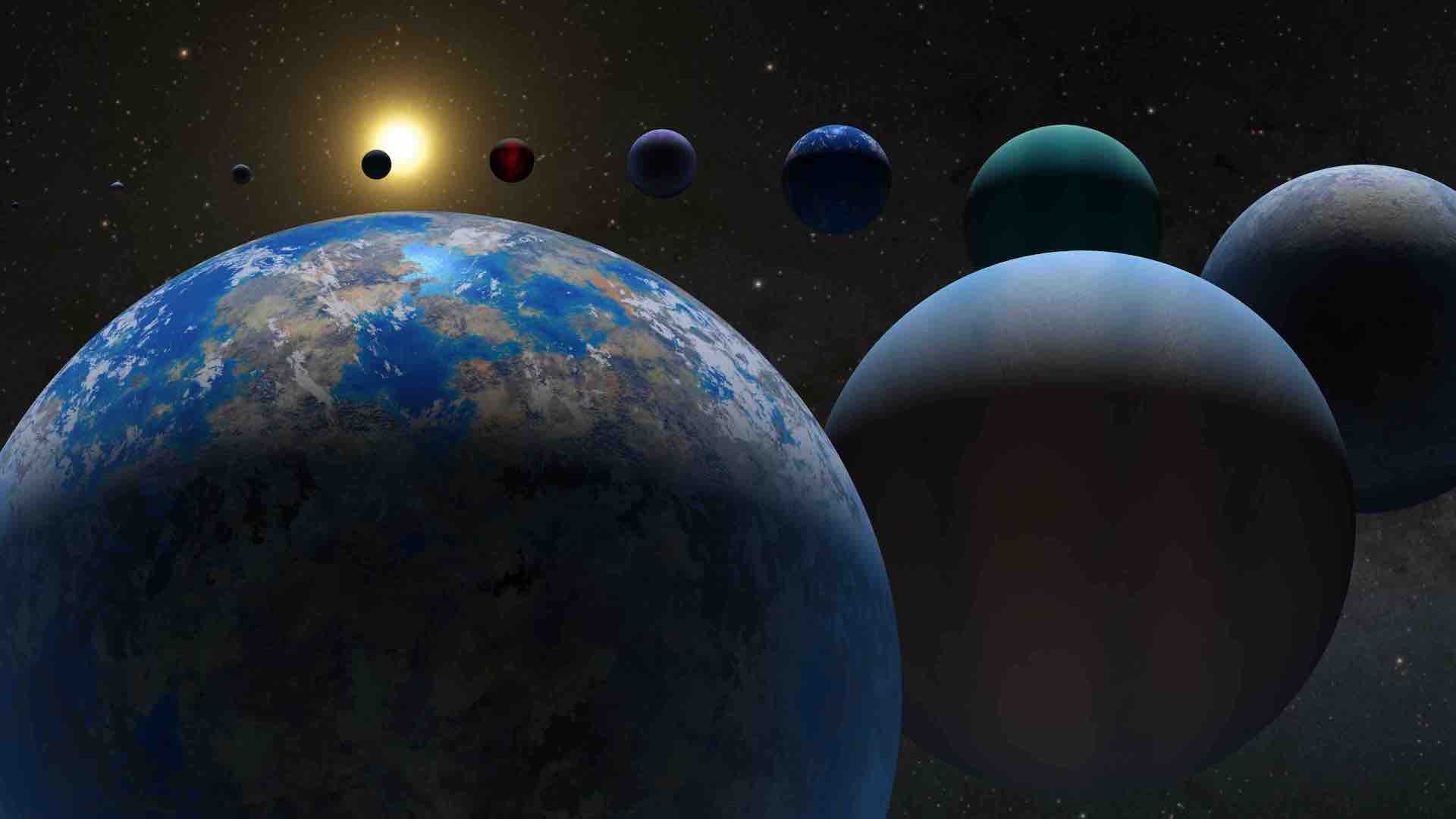 NASA/JPL-Caltech
NASA/JPL-Caltech
Despite thousands of exoplanet discoveries over the past few decades enabled by ground- and space-based surveys, our census of the exoplanet population remains incomplete.
Targeted radial velocity (RV) searches have been successful at detecting massive planets at short orbital periods around sun-like stars, and even terrestrial-mass planets around M dwarfs.
RV surveys have now begun to achieve the long baselines required to detect some massive "cool" giants beyond the snowline, enabling early demographic studies of this long-period population.
Synoptic transit surveys like Kepler and TESS have also been extremely successful at measuring the sizes of large, relatively close-in planets, as well as small terrestrial planets around cool stars and some sun-like stars.
Additionally, advances in ground-based direct imaging have led to the detection and characterization of giant planets still in their infancy at very wide orbital separations.
However, the population of small, terrestrial planets at temperate orbital separations has remained largely unexplored due to observational challenges.
Unlocking this key region of parameter space, home to an unknown number of potentially-habitable worlds, is the next chapter in the saga of exoplanet exploration.
Measuring nearby planetary system architectures
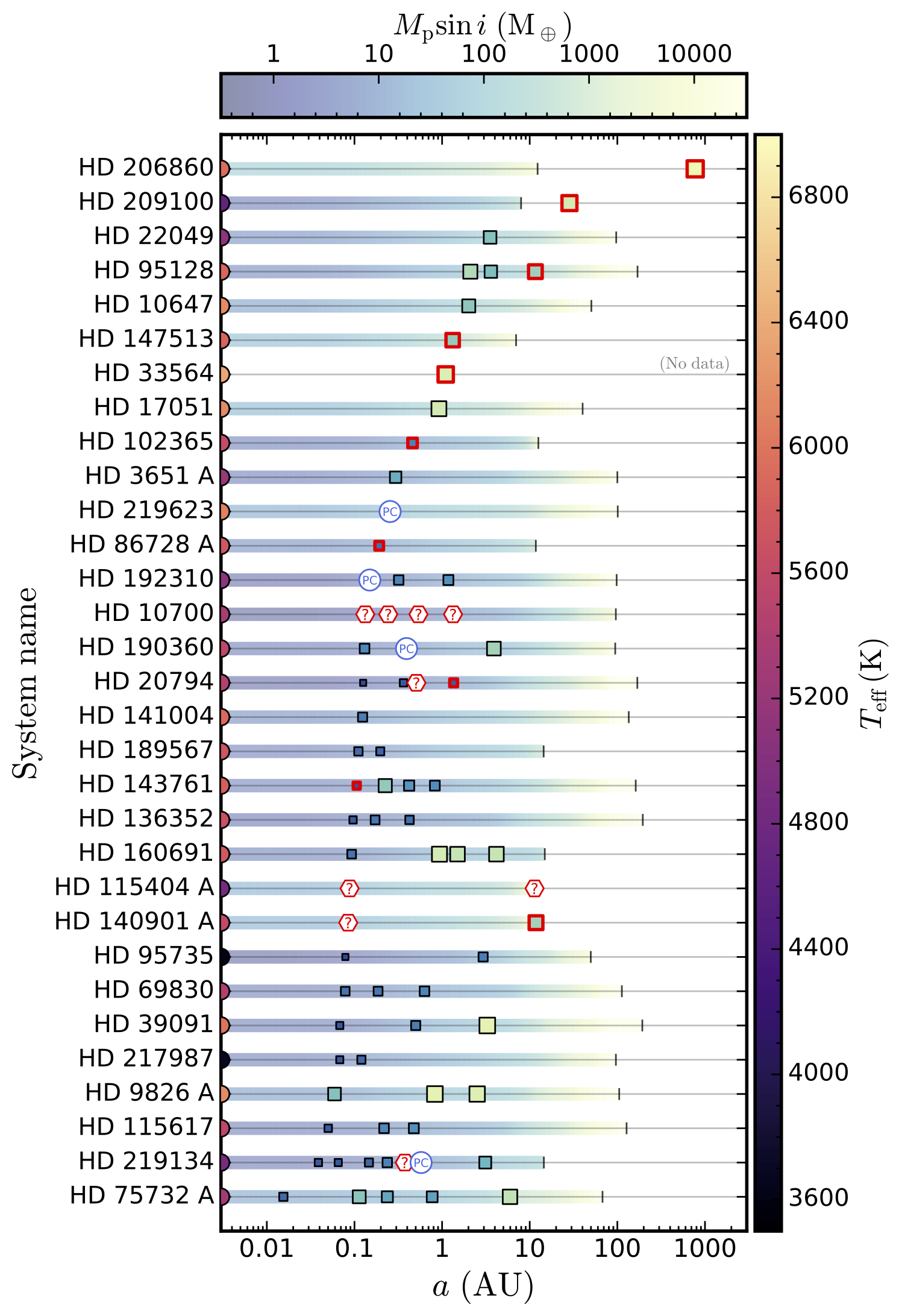 Figure 1. (Harada et al. 2025)
Figure 1. (Harada et al. 2025)
What is the range of planetary system architectures and is the configuration of the Solar System common?
How do habitable environments arise and evolve within the context of their planetary Systems?
These are some of the key science questions at the bleeding edge of exoplanetary research (Astro2020 Decadal).
Detections of Earth-size planets at Earth-like separations from Sun-like stars will become more and more common with future advances in extreme precision RV (EPRV), improved transit surveys, and revolutionary facilities like ground-based extremely large telescopes (ELTs) and large, space-based coronagraphic observatories.
As they do, a robust understanding of the astrophysical contexts in which these Earth-like worlds reside is necessary to assess their potential to be habitable.
Only with this context can we begin to learn about which architectures of planetary systems are typical, how potentially-habitable environments are formed, and what dominant processes influence habitability.
Future ELTs and space-based observatories will directly measure exoplanets at orbital separations previously unprobed by other detection techniques, including planets in the habitable zones (HZs) of Sun-like host stars.
The Habitable Worlds Observatory (HWO) is the next-generation flagship NASA mission concept, slated for the 2040s.
HWO will be a large, space-based, ultra-stable, UV/optical/NIR observatory that will use wavefront correction and starlight suppression technology to directly image the HZs of neary Sun-like stars.
A primary goal of HWO is to discover and spectroscopically characterize dozens of Earth-analog planets and determine whether they exhibit signs of global biospheres.
HWO and other direct imaging missions will start by studying the closest stars to the Solar System, where the HZ angular separations are relatively large and the faint starlight reflected by small planets is easier to detect.
However, there is only a finite number of nearby stars that will be accessible to DI missions like HWO.
Therefore, these are the highest-priority targets for precursor studies of planetary system architectures because future DI will enable the most comprehensive view of small planets at wide orbital separations.
 Figure 2. (Harada et al. 2025)
Figure 2. (Harada et al. 2025)
We also care about the system architectures of future DI target stars because they inform which targets should be prioritized for which science goals.
For example, if HWO seeks to identify Earth-like planets in the HZ, it is crucial to select targets that we know do not possess massive disruptive planets in the HZ.
This is also crucial information for engineering trade studies.
If a large fraction of HWO target stars possess giant HZ planets, which are incompatible with smaller Earth-size planets in the same orbit, then these targets will not be suitable for searching for exo-Earths.
This would mean that additional, more distant target stars would need to be added to the survey, possibly requiring a telescope with a larger aperture and a coronagraph with a more aggressive inner working angle (IWA).
The sooner we can identify such targets, the easier and less costly will be to ajust key engineering decisions regarding HWO's design.
In Harada et al. (2025)
we analyzed over 35 years of archival RV data to constrain the system architectures of 120 promising targets for future DI exoplanet missions, including the HWO exo-Earth survey.
Using a Bayesian search and orbit fitting framework, we searched for Keplerian signals, fit the orbits of known planets, and measured the search efficiency as a function of minimum planet mass and semi-major axis.
We analyzed over 150,000 individual RV measurements that were collected from more than 20 different spectrographs around the world since 1987.
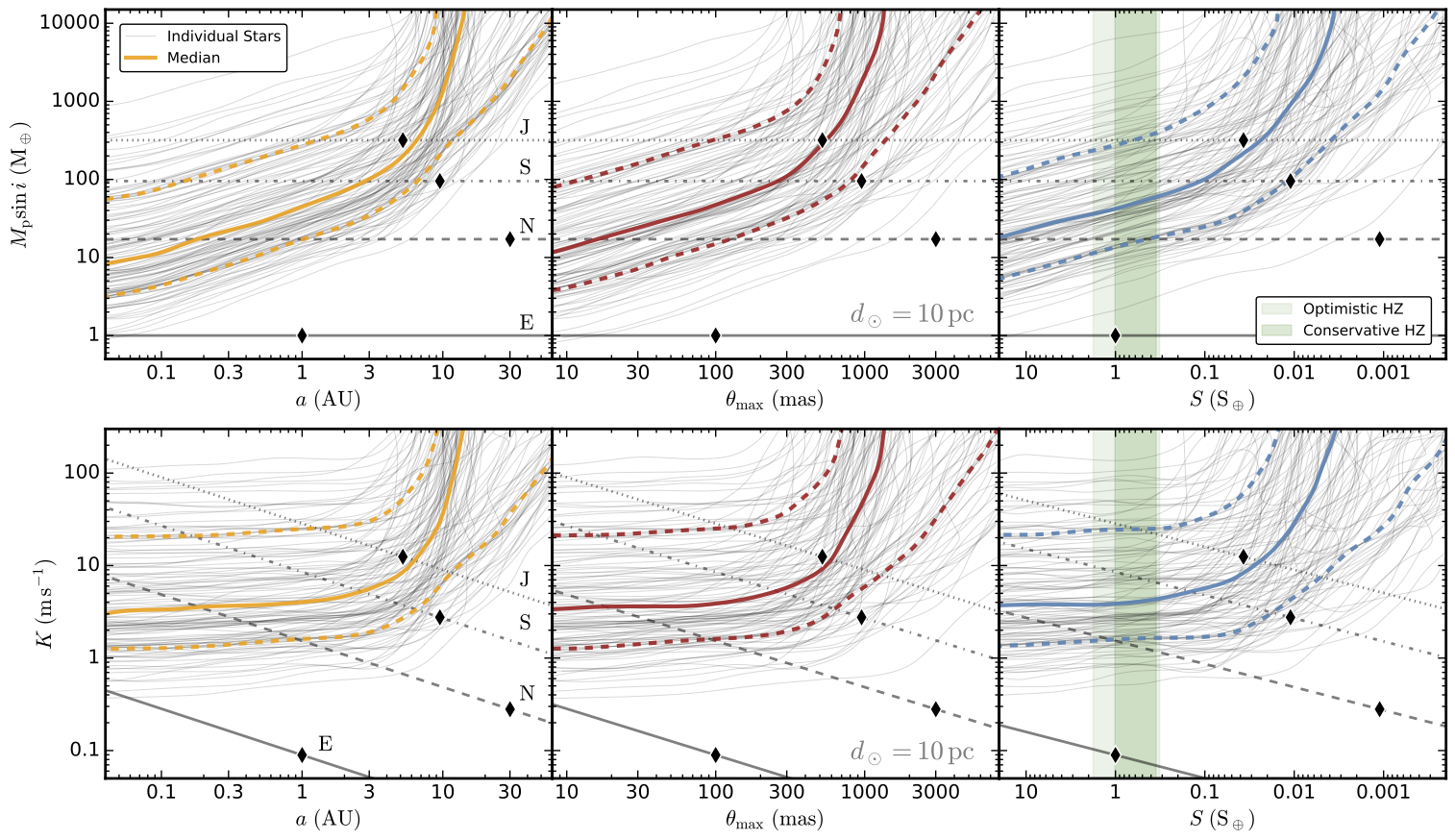 Figure 3. (Harada et al. 2025)
Figure 3. (Harada et al. 2025)
We calculated updated parameters for 53 known companions, and we detected at least 26 additional RV signals corresponding to stellar activity and 4 signals that were planet candidates.
We derived RV sensitivity limits as a function of semi-major axis, instellation flux, and maximum angular separation for all 120 stars with at least 20 RV epochs.
Figure 1 shows the system architectures of the stars with at least one known planet or planet candidate.
Figure 2 shows am RV search completeness map for the star HD 190360, computed from empirical injection and recovery tests.
Figure 3 the 50% detection efficiency level for all 120 stars expressed in different parameters.
For complete descriptions of these figures, see the captions of Figures 5, 7, and 12 in Harada et al. (2025).
A key results from this analysis is that, based on the empirical search completeness tests, the median mass sensitivity limit in the middle of the conservative HZ is approximately 48 Earth masses.
Importantly, this implies that undetected Jupiter-mass planets may be hiding in up to 38% of the HZs of targets in the sample.
Undetected Saturn-mass planets could be hiding in up to 53% of the systems' HZs, and Neptune-mass planets in the HZs of up to 82% of systems.
Each of these planet types could lead to dynamically unstable conditions for potential Earth-mass planets in the HZ.
Therefore, we concluded that additional observations to constrain planet masses are urgently needed.
Moderate-precision RV facilities are well-suited for this task.
Read more
More highlights

Evaluating circumstellar environments
The Decadal Survey on Astronomy and Astrophysics 2020 has recommended that NASA realize a large
IR/optical/UV space telescope optimized for high-contrast imaging and spectroscopy of ~25 exo-Earths
and transformative general astrophysics. The NASA Exoplanet Exploration Program (ExEP) has subsequently
released a list of 164 nearby (d < 25 pc) targets deemed the most accessible to survey for potentially
habitable exoplanets with the Habitable Worlds Observatory (HWO). We present a catalog of system
properties for the 164 ExEP targets, including 1744 abundance measurements for 14 elements from the
Hypatia Catalog and 924 photometry measurements spanning from 151.6 nm to 22 μm in the GALEX, Strömgren,
Tycho, Gaia, Two Micron All Sky Survey, and Wide-field Infrared Survey Explorer bandpasses. We
independently derive stellar properties for these systems by modeling their spectral energy distributions
with Bayesian model averaging. Additionally, by consulting the literature, we identify TESS flare rates
for 46 stars, optical variability for 78 stars, and X-ray emission for 46 stars in our sample. We discuss
our catalog in the context of planet habitability and draw attention to key gaps in our knowledge where
precursor science can help to inform HWO mission design trade studies in the near future. Notably, only
33 of the 164 stars in our sample have reliable space-based UV measurements, and only 40 have a mid-IR
measurement. We also find that phosphorus, a bioessential element, has only been measured in 11 of
these stars, motivating future abundance surveys. Our catalog is publicly available and we advocate
for its use in future studies of promising HWO targets. (Harada et al. 2024)
Read more
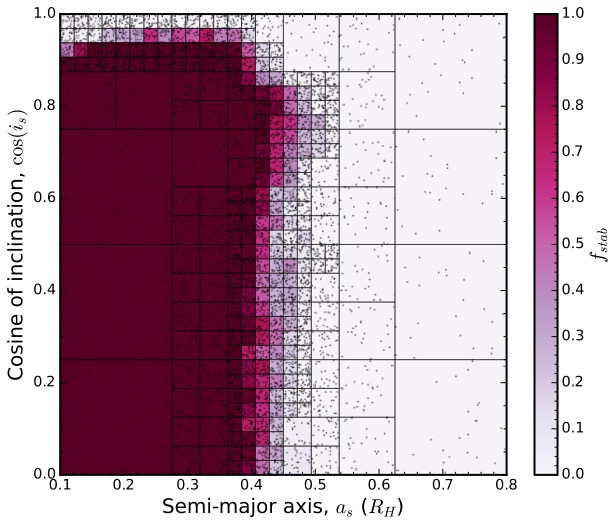
Constraining exomoons orbiting temperate giants
Moons orbiting exoplanets ("exomoons") may hold clues about planet formation, migration, and habitability.
In this work, we investigate the plausibility of exomoons orbiting the temperate giant planet HIP 41378 f,
which has been shown to have a low apparent bulk density of 0.09 g/cc and a flat near-infrared transmission
spectrum, hinting that it may possess circumplanetary rings. Given this planet's long orbital period (P=1.5 yr),
it has been suggested that it may also host a large exomoon. Here, we analyze the orbital stability of a hypothetical
exomoon with a satellite-to-planet mass ratio of 0.0123 orbiting HIP 41378 f. Combining a new software package,
astroQTpy, with REBOUND and EqTide, we conduct a series of N-body and tidal migration simulations, demonstrating
that satellites up to this size are largely stable against dynamical escape and collisions. We simulate the expected
transit signal from this hypothetical exomoon and show that current transit observations likely cannot constrain the
presence of exomoons orbiting HIP 41378 f, though future observations may be capable of detecting exomoons in other
systems. Finally, we model the combined transmission spectrum of HIP 41378 f and a hypothetical moon with a
low-metallicity atmosphere and show that the total effective spectrum would be contaminated at the ~10 ppm level.
Our work not only demonstrates the feasibility of exomoons orbiting HIP 41378 f but also shows that large exomoons
may be a source of uncertainty in future high-precision measurements of exoplanet systems. (Harada et al. 2023)
Read more
Aerosol Feedback in Exoplanet Atmospheres
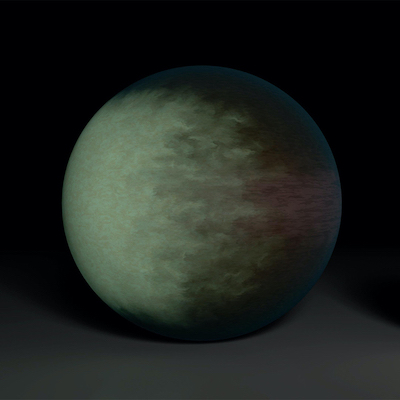 NASA/JPL-Caltech/MIT
NASA/JPL-Caltech/MIT
Clouds and hazes (or, more generally, aerosols) are ubiquitous to planets and moons with thick atmospheres in our Solar System.
Yet we still don't fully understand the range of possible aerosols compositions, physical properties, spatial extents, and formation pathways.
Observations and theory tell us that aerosols must also exist in the atmospheres of exoplanets, but our knowledge is even more restricted by the limitations of remote sensing.
However, aerosols may have a significant impact on atmospheric radiative processes, gas abundances, and dynamics, and therefore pose a major challenge for interpreting observations of exoplanetary atmospheres.
A deeper understanding of exoplanet cloud physics is necessary to enable more accurate atmospheric modeling and interpretation.
This has applications across the spectrum of exoplanet characterization, from testing theories of giant planet formation and migration to making robust detections of biosignatures on Earth-like exoplanets.
Highlights

Modeling emission spectra of cloudy hot Jupiters at high spectral resolution
Observations of scattered light and thermal emission from hot Jupiter exoplanets have suggested the presence of
inhomogeneous aerosols in their atmospheres. 3D general circulation models (GCMs) that attempt to model the effects
of aerosols have been developed to understand the physical processes that underlie their dynamical structures. In
this work, we investigate how different approaches to aerosol modeling in GCMs of hot Jupiters affect high-resolution
thermal emission spectra throughout the duration of the planet's orbit. Using results from a GCM with temperature-dependent
cloud formation, we calculate spectra of a representative hot Jupiter with different assumptions regarding the vertical
extent and thickness of clouds. We then compare these spectra to models in which clouds are absent or simply post-processed
(i.e., added subsequently to the completed clear model). We show that the temperature-dependent treatment of clouds in
the GCM produces high-resolution emission spectra that are markedly different from the clear and post-processed cases—both
in the continuum flux levels and line profiles—and that increasing the vertical extent and thickness of clouds leads to
bigger changes in these features. We evaluate the net Doppler shifts of the spectra induced by global winds and the
planet's rotation and show that they are strongly phase dependent, especially for models with thicker and more extended
clouds. This work further demonstrates the importance of radiative feedback in cloudy atmospheric models of hot Jupiters,
as this can have a significant impact on interpreting spectroscopic observations of exoplanet atmospheres. (Harada et al. 2021)
Read more

 NASA/JPL-Caltech
NASA/JPL-Caltech Figure 1. (Harada et al. 2025)
Figure 1. (Harada et al. 2025) Figure 2. (Harada et al. 2025)
Figure 2. (Harada et al. 2025) Figure 3. (Harada et al. 2025)
Figure 3. (Harada et al. 2025)
 NASA/JPL-Caltech/MIT
NASA/JPL-Caltech/MIT